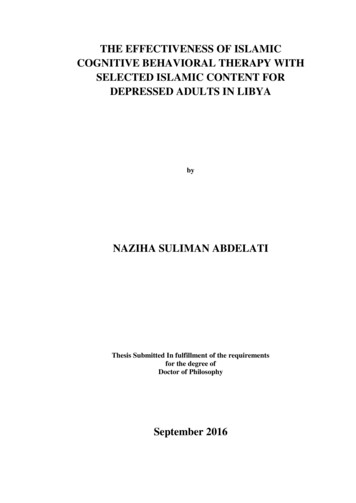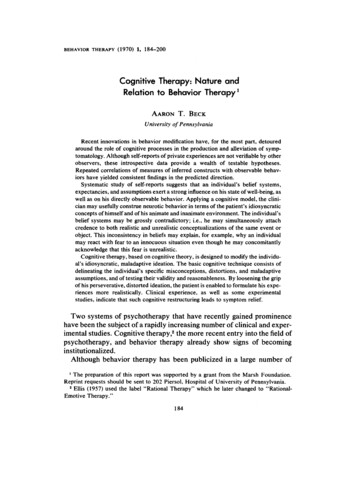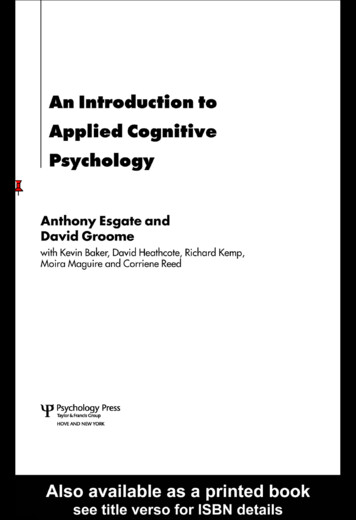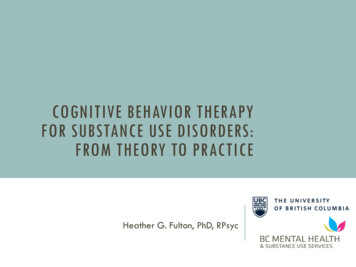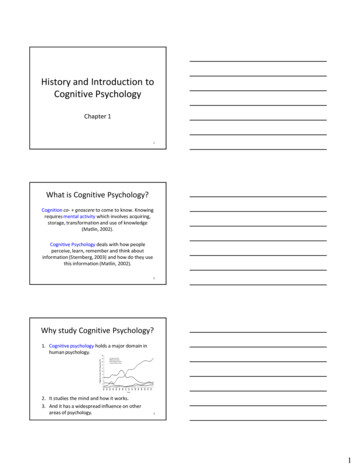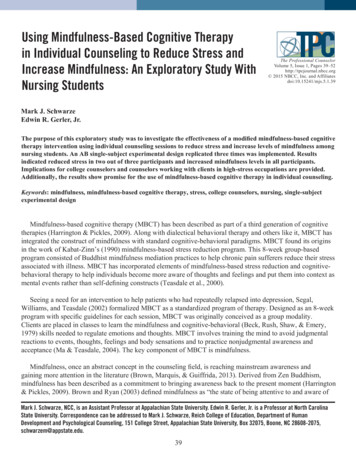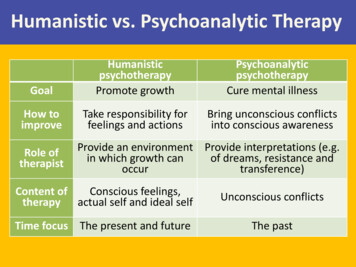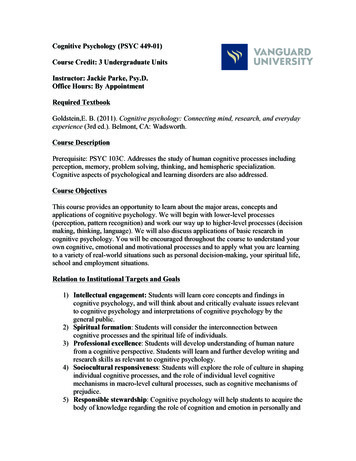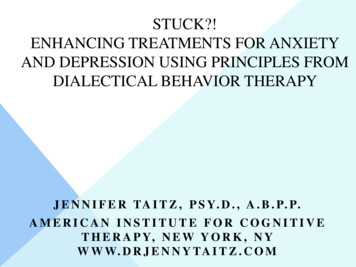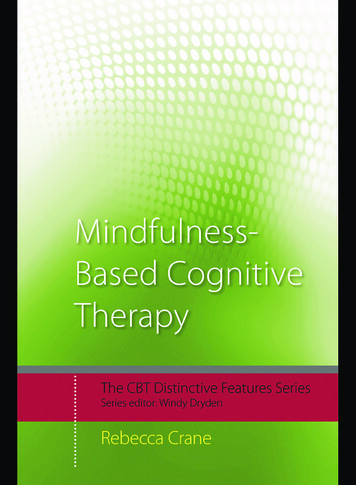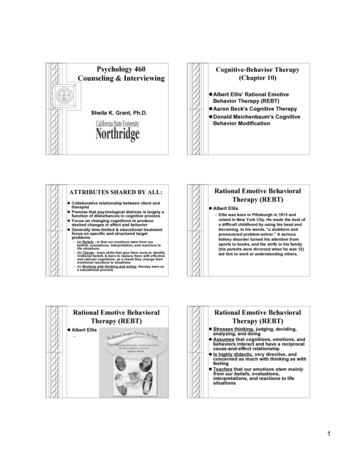
Transcription
Psychology 460Counseling & InterviewingSheila K. Grant, Ph.D.ATTRIBUTES SHARED BY ALL: Collaborative relationship between client andtherapist Premise that psychological distress is largely afunction of disturbances in cognitive process Focus on changing cognitions to producedesired changes in affect and behavior Generally time-limited & educational treatmentfocus on specific and structured targetproblems– (a) Beliefs - is that our emotions stem from ourbeliefs, evaluations, interpretation, and reactions tolife situations– (b) Clients - learn skills that give them tools to identifyirrational beliefs & learn to replace them with effectiveand rational cognitions; as a result they change theiremotional reactions to situations– (c) Working with thinking and acting; therapy seen asa educational processRational Emotive BehavioralTherapy (REBT) Albert Ellis–Cognitive-Behavior Therapy(Chapter 10) Albert Ellis’ Rational EmotiveBehavior Therapy (REBT) Aaron Beck's Cognitive Therapy Donald Meichenbaum's CognitiveBehavior ModificationRational Emotive BehavioralTherapy (REBT) Albert Ellis– Ellis was born in Pittsburgh in 1913 andraised in New York City. He made the best ofa difficult childhood by using his head andbecoming, in his words, "a stubborn andpronounced problem-solver." A seriouskidney disorder turned his attention fromsports to books, and the strife in his family(his parents were divorced when he was 12)led him to work at understanding others.Rational Emotive BehavioralTherapy (REBT) Stresses thinking, judging, deciding,analyzing, and doing Assumes that cognitions, emotions, andbehaviors interact and have a reciprocalcause-and-effect relationship Is highly didactic, very directive, andconcerned as much with thinking as withfeeling Teaches that our emotions stem mainlyfrom our beliefs, evaluations,interpretations, and reactions to lifesituations1
The Therapeutic ProcessKey Concepts View of Human Nature Therapy is seen as an educationalprocess Clients learn– To identify & dispute irrational beliefsthat are maintained by selfindoctrination– To replace ineffective ways of thinkingwith effective & rational cognitions– To stop absolutistic thinking, blaming,& repeating false beliefs– We are born with a potential for both rational andirrational thinking– We have the biological & cultural tendency to thinkcrookedly & to needlessly disturb ourselves– We learn and invent disturbing beliefs and keepourselves disturbed through our self-talk– We have the capacity to change our cognitive,emotive, and behavioral processes– Help people accept themselves as able to makemistakes & yet be at peace with themselves– Humans are self-talking, self-evaluating, selfsustaining– There is inborn tendency toward self-actualization,but its sabotaged by inborn tendency toward crookedthinking & self-defeating patterns that are learnedKey ConceptsKey Concepts View of Emotional Disturbance View of the world– Our own repetition of early-indoctrinatedirrational beliefs keeps dysfunctionalattitudes operative within us– Blame is the core of most emotionaldisturbances– People develop difficulties when theymistake simple preferences (desires for love,approval, success) and make the mistake ofthinking of them as dire needs– Absolutistic cognitions are the core ofhuman misery "musts" & "shoulds"– Most people conceptualize their world as Acauses C.– I.e., that events/experiences cause them tofeel a certain way– Also we subscribe to irrational beliefsKey ConceptsKey Concepts Irrational Beliefs (Albert Ellis) Irrational Beliefs (Albert Ellis)– 1. You must - yes, must - have sincere love andapproval almost all the time from all the people youfind significant– 2. You must prove yourself thoroughly competent,adequate and achieving, or you must at least havereal competence or talent at something important– 3. You have to view life as awful, terrible, horrible, orcatastrophic when things do not go the way youwould like them to go– 4. People who harm you or commit misdeed rate asgenerally bad, wicked, or villainous individuals andyou should severly blame, damn, and punish them fortheir sins– 5. If something seems dangerous or fearsome, youmust become terribly occupied with and upset aboutit– 6. People and things should turn out better than theydo and you have to view it as awful and horrible if youdo not quickly find good solutions to life’s hassels– 7. Emotional misery comes from external pressuresand you have little ability to control your feelings orrid yourself of depression and hostility– 8. You will find it easier to avoid facing many of life’sdifficulties and self-responsibilities than to undertakemore rewarding forms of self-discipline– 9. Your past remains all-important and becausesomething once strongly influenced your life, it has tokeep determining your feelings and behavior today– 10. You can achieve happiness by inertia and inactionor by passively and uncommitedly “enjoyingyourself”2
Key ConceptsA-B-C Theory of Personality Irrational Beliefs (Arthur Lange) can be brokendown to 4 categories:– a. People worry too much about what other peoplethink– b. People have a fear of failure– c. People have a low frustration tolerance– d. People have a tendency to externalize blame– Note: Clients do not typically do all four, more likelyto have one core irrational beliefA-B-C Theory of PersonalityA-B-C Theory of Personality At point A (an Activating Experience orActivating Event) something occurs. Forexample, you have a good job and get firedfrom it. At point C, an emotional and/or behavioralConsequence, clients react to the happening atpoint A, and, e.g., feel quite depressed about yourjob loss and tend to stay home much of the timeand avoid going out to look for another equivalent,or perhaps even better, job.A-B-C Theory of PersonalityA-B-C Theory of Personality Noting, now, that the emotional and behavioral Consequence(C) almost immdeiately and directly follows after theoccurrence of the Activating experience (A), clients falselytend to assume that A causes C. And they erroneously make conclusions like: “I lost this goodjob and that, my loss, has depressed me and made me avoidlooking for another one.” REBT theory strongly posits, then, that ActivatingExperiences at A, like the loss of a job, do not make clientshave emotional Consequences at C, such as feelings ofdepression, despair, and panic, and do not lead to behavioralConsequences such as inertia and avoidance. Rather, clients mainly cause their own consequences, at C,by strongly believing certain things at B--their innatelypredisposed and learned or acquired Belief System.3
A-B-C Theory of PersonalityA-B-C Theory of Personality So says the central theory of REBT (as Epictetus observedsome 2000 years ago): And further:– The things that occur do not upset you--but your view of thosethings does.– Or, in REBT terms, A (Activating Event) does not directly causeC (emotional and behavioral Consequences); B (clients’ Beliefsabout A) does.– Once clients accept the fact that external events(including early conditioning) significantly contribute to butdo not actually cause their feelings, and that they largelyfeel the way they think, they enormously increase theirpower over their own emotions.– Although clients can hardly change them at will, they canappreciably make them subject to their decisionprocesses.A-B-C Theory of PersonalityA-B-C Theory of Personality And further: Challenging any irrational or rationalizedthinking– They can, if they wish, decide to surrender to appropriatenegative emotions, such as sorrow, regret, frustration,annoyance, and irritation, while refusing very often to givein to inappropriate and self-defeating feelings, such asanxiety, depression, hostility, and self-downing.– How?– By finishing the A-B-C’s of REBT with the D and E–––––What’s true about Self?What’s true about Others?What’s true about Situation?Is this consequence inevitable?Is it true that this should never happen? Whosaid?A-B-C Theory of PersonalityA-B-C Theory of Personality Challenging any irrational or rationalizedthinking Substitute specific rational thoughts thatwhen thought, lead to less anxiety, anger,guilt or depression These thoughts must be true and be directlycounter to the thoughts that were disruptive– Where’s the evidence?– Why is it important? (answer: because everyonemust approve of me)– Where’s the evidence?4
A-B-C Theory of PersonalityThe Therapeutic Process Clients experience in therapy– 1. Client is in role of a learner– 2. Emphasis on here and now experiences– 3. Three main levels of insight in REBT: Winding up with a New Effect or Philosophy– Replace with Rational Beliefs by Actively Disputing IrrationalBeliefs and– Simultaneously identify what’s the good stuff (I.e., reinforcewhat already exists or replace with new beliefs)– Along with this cognitive Effect (cE), or new philosophy,they will, if they truly believe in it and follow what theybelieve, have a new emotive Effect (eE) and behavioral (be)as well, e.g., “You will feel undepressed (though still sorry)and unanxious (though still concerned) 1st we choose to disturb ourselves about eventsin our lives 2nd we remain emotionally disturbed because wekeep re-indoctrinating ourselves with absolutisticbeliefs 3rd there are no magical ways to change ourpersonalities, we change only if we are willing towork and practiceA-B-C Theory of PersonalityThe Therapeutic Process The reaction (C) to an event (A) can be eitherappropriate or inappropriate; however A does not cause C, instead B - theperson's belief about A causes C. D is application of scientific method to helpclients challenge their irrational beliefs. Three components of disputing process: Primary Therapeutic Goals– 1. detecting- clients detect their irrational beliefs,especially absolutistic ones– 2. debating- clients debate dysfunctional beliefs bylearning to empirically question them and arguethemselves out of believing them– 3. discriminating- learn to discriminate rational fromirrational beliefsThe Therapeutic Process General Therapeutic Goals––––––––––––1. self- interest2. social interest3. self-direction4. tolerance5. flexibility6. acceptance of uncertainty7. commitment8. scientific thinking9. self-acceptance10. risk taking11. high tolerance of frustration12. self-responsibility for disturbance– to leave clients, at the end of psychotherapeuticprocess, with a minimum of anxiety, guilt,depression (or self-blame), anger, and lowfrustration tolerance (or blame of others and theworld around them); just as importantly,– to give them a method of self-observation andself-assessment that will ensure that, for the restof their lives, they will continue to makethemselves minimally anxious and hostileThe Therapeutic Process Therapist's Function and Role– 1. show clients they have many irrational"shoulds", "oughts", "musts” (musturbation)– 2. demonstrate to client that they are keepingtheir emotional disturbances active bycontinuing to think illogically and byrepeating self-defeating meanings andphilosophies– 3. help clients modify their thinking andirrational ideas– 4. challenge clients to devise a rationalphilosophy of life so that in the future, theycan avoid becoming victims of irrationalbeliefs5
The Therapeutic Process Relationship between therapist andclient– 1. full acceptance/tolerance of client– 2. help clients avoid self-condemnation– 3. refuse to evaluate clients as persons, butrather point out ineffectual behavior– 4. does not emphasis personal warmth andempathy rather, model and teachunconditional full acceptance transferencenot encouragedApplication:The Practice of REBT Emotive techniques– Rational emotive imagery– Role playing– Shame attacking exercises; exercisesto help people reduce irrational shameover behaving in certain ways– Use of force and vigor- as a way to gofrom intellectual to emotional insightIrrational Ideas Irrational ideas lead to selfdefeating behavior Some examples:Application:The Practice of REBT Incorporate into therapy a forcefulcognitive methodology– dispute irrational beliefs– cognitive homework client makes list of problems, look forabsolutistic beliefs, and dispute thesebeliefs changing one's language; "oughts" and"shoulds" preferences use of humorApplication:The Practice of REBT Applications of REBT can apply to :– Individual therapy– Group therapy– Brief therapy– Marital therapy– Application to family therapyAaron Beck’sCognitive Therapy (CT) Beck & daughter– Dr. Judith Beck– “I must have love or approval from allthe significant people in my life.”– “I must perform important taskscompetently and perfectly.”– “If I don’t get what I want, it’s terrible,and I can’t stand it.”6
Aaron Beck’sCognitive Therapy (CT)Aaron Beck’sCognitive Therapy (CT) Graduate of Brown University (1942) and YaleMedical School (1946) Developed cognitive therapy in early 1960s as apsychiatrist at the University of Pennsylvania Had previously studied and practicedpsychoanalysis A researcher and scientist at heart, Dr. Beckdesigned & carried out a number of experimentsto test psychoanalytic concepts of depression Fully expecting research would validate thesefundamental precepts, he was surprised to findthe opposite This research led him to begin to look for otherways of conceptualizing depression Working with depressed patients, he found thatthey experienced streams of negative thoughtsthat seemed to pop up spontaneously He termed these cognitions “automaticthoughts,” & discovered that their content fellinto three categories: negative ideas aboutthemselves, the world and the future He began helping patients identify and evaluatethese thoughts and found that by doing so,patients were able to think more realistically,which led them to feel better emotionally andbehave more functionallyAaron Beck’sCognitive Therapy (CT) Sensitizing even-- Indv. Is now-- Current event/situ(stressor early in life) stionSelfimpinges on sensitiveareaAppraisalOf LOSSSadnessDepressionSelf DefectiveNegativeGeneraliztionof SOS/worldCondition isPermanentAaron Beck’sCognitive Therapy (CT) Vicious cycle intensifies as the sense ofsadness is continually fed May reach the point where only means ofescape evident to the depressive is suicide Key is to break the dysfunctional thoughtprocessLow motivation,sleep/eat disruptionAaron Beck’sCognitive Therapy (CT) Active, directive, time-limited, presentcentered, structured approach Insight-focused therapy Emphasizes changing negative thoughtsand maladaptive beliefs (schemata) Theoretical Assumptions– People’s internal communication isaccessible to introspection– Clients’ beliefs have highly personalmeanings– These meanings can be discovered by theclient rather than being taught or interpretedby the therapistTheory, Goals & Principles of CT Basic theory:– To understand the nature of an emotional episodeor disturbance it is essential to focus on thecognitive content of an individual’s reaction to theupsetting event or stream of thoughts Goals:– To change the way clients think by using theirautomatic thoughts to reach the core schemata andbegin to introduce the idea of schema restructuringdone by encouraging clients to gather & weigh theevidence in support of their beliefs Principles:– Automatic thoughts: personalized notions that aretriggered by particular stimuli that lead toemotional responses7
CT’s Cognitive Distortions Errors in reasoning that lead to cognitivedistortions– Arbitrary inferences making conclusions w/o supporting & relevantevidence E.g., fooled professors & somehow managed toget degree but now people will certainly seethrough you– Selective abstraction Forming conclusions based on an isolated detailof an event Other info. Is ignored & significance of totalcontext ignored E.g., as counselor might measure your worth byyour errors & weaknesses, not by your successesCT’s Cognitive Distortions Errors in reasoning that lead to cognitivedistortions– Personalization Tendency for individuals to relate external eventsto themselves, even when there is no basis formaking this connection E.g., client d/n return to 2nd session so must bemy fault they will never seek help again– Labeling and mislabeling Portraying one’s identity on the basis ofimperfections & mistakes made in the past &allowing them to define one’s true identify E.g., if not able to live up to all client’sexpectations then might think ‘totally worthless astherapist’CT’s Cognitive Triad Pattern that triggers depression:1. Client holds negative view ofthemselves2. Selective abstraction: Client hastendency to interpret experiences in anegative manner3. Client has a gloomy vision andprojections about the futureCT’s Cognitive Distortions Errors in reasoning that lead to cognitivedistortions– Overgeneralization Process of holding extreme beliefs on basis of asingle incident & applying them inappropriately todissimilar events or setting E.g., You might conclude that you will not beeffective counseling adolescents; you might alsoconclude that you will not be effective workingwith any clients– Magnification and minimization Perceiving a case or situation in a greater orlesser light than it truly deserves E.g., By assuming that even minor mistakes incounseling a client could easily create a crisis forthem and might result in psychological damageCT’s Cognitive Distortions Errors in reasoning that lead to cognitivedistortions– Polarized thinking Thinking & interpreting in all-or-nothing terms,categorizing experiences in either-or extremes Dichotomous thinking--events are labeled in black orwhite terms (e.g., competent counselor & alwayssuccessful OR not fully competent and a total flop Homework– Pleasure Sheet [predict satisfaction before then listactual satisfaction after]– Anti-procrastination Sheet [predict difficulty &satisfaction, then list actual difficulty/satisfaction]– Automatic Thought Sheet [automatic thought (selfcriticism), type of distortion, rational response (selfdefense)]Beck’s CT: Clinical Procedures Prepare client by providing cognitive rationalefor treatment and demystify treatment Applying client to monitor thought thataccompany distress Implementing behavioral and cognitivetechniques Identifying and challenging cognitions Examining beliefs and assumptions by testingthem in reality Preparing clients by teaching them copingskills that will work against relapse8
Constructivism as a trend incognitive therapyDifferences between CT & REBT Stresses the client's reality withoutdisputing whether its accurate orrational An advantage of less danger of therapistimposing their own views on client This approach provides a philosophicalapproach not really a set of techniques View of people as active agents who canderive meaning out of their experientialworld REBT is very directive, persuasive, confrontive CT however places more emphasis on helpingclients discover their misconceptions forthemselves CT puts more emphasis on the therapeuticrelationshipDonald Meichenbaum’sCognitive Behavior Modification(CBM)Donald Meichenbaum’sCognitive Behavior Modification(CBM) Dr. Meichenbaum is Professor of Psychology atthe University of Waterloo in Ontario, Canadaand a member of The American Academy ofExperts in Traumatic Stress He was the innovator of Cognitive BehaviorModification (CBM) and at the forefront of the"Cognitive Revolution" in the field ofpsychology in the 1970s and 1980s He was voted one of the ten most influentialpsychotherapists of the century by NorthAmerican clinicians in a survey reported in theAmerican Psychologist, the official publicationof the American Psychological AssociationMeichenbaum’s CBM Self-instructional therapy focus:– Trains clients to modify the instructions theygive to themselves so that they can cope– Emphasis is on acquiring practical copingskills Cognitive structure:– The organizing aspect of thinking, whichseems to monitor and direct the choice ofthoughts– The “executive processor,” which “holds theblueprints of thinking” that determine whento continue, interrupt, or change thinking– therapist must have genuine warmth, accurateempathy, non judgmental acceptance– therapist functions as a catalyst and a guide whohelps clients understand how their beliefs affect howthey feel– there is a therapeutic collaboration between therapistand client Self-instructional therapy, form ofcognitive-restructuring Focus:– Client’s self-verbalizations or self-statements Premise:– As a prerequisite to behavior change, clientsmust notice how they think, feel, and behave,and what impact they have on others Basic assumption:– Distressing emotions are typically the resultof maladaptive thoughtsBehavior Change & Coping(CBM) Behavior change occurs through asequence of mediating processesinvolving interaction of innerspeech, cognitive structures, andbehaviors and their resultantoutcomes 3 Phases of Behavior Change1. Self-observation2. Starting a new internal dialogue3. Learning new skills9
Behavior Change & Coping(CBM) Coping skills programs – Stressinoculation training(3 phase model)1. The conceptual phase2. Skills acquisition and rehearsalphase3. Application and follow-throughphaseCoping skills programs Rationale is that we can acquire moreeffective strategies in dealing withstressful situations by learning how tomodify our cognitive "set“– 1. expose clients to anxiety provokingsituations by means of role playing andimagery– 2. require clients to evaluate their anxietylevel– 3. teach clients to become aware of anxietyprovoking cognitions they have in stressfulsituations– 4. helping clients examine these thoughts byreevaluating their self-statementsCoping skills programs Stress-Inoculation Training (SIT)– Three stages Conceptual phase: create a workingrelationship with clientsSkills-acquisition and rehearsal phase:giving clients a variety of behavioral andcognitive coping techniques to apply tostressful situationsApplication and follow-through phase:focus transfer and maintenance ofchange from the therapeutic situation toreal world10
6 The Therapeutic Process Relationship between therapist and client -1. full acceptance/tolerance of client -2. help clients avoid self-condemnation -3. refuse to evaluate clients as persons, but rather point out ineffectual behavior -4. does not emphasis personal warmth and empathy rather, model and teach unconditional full acceptance transference
